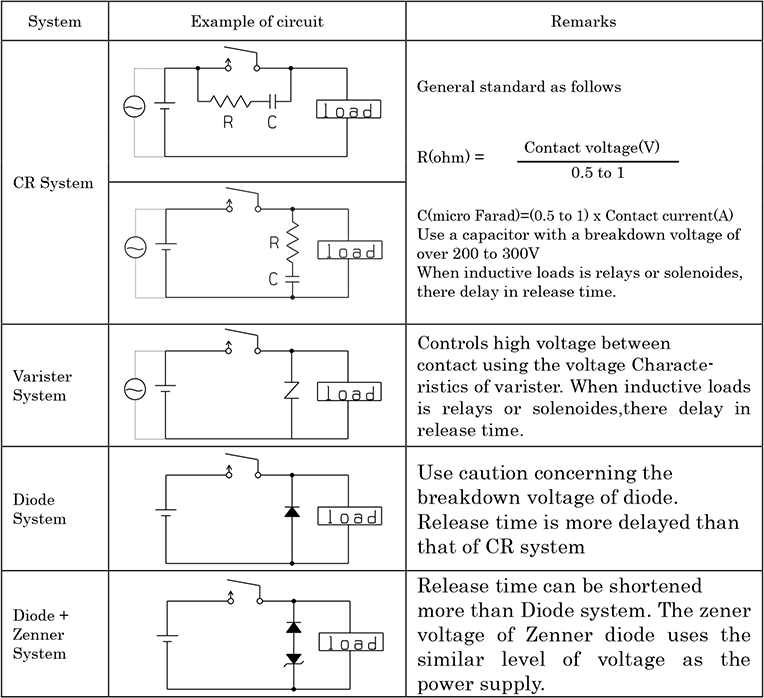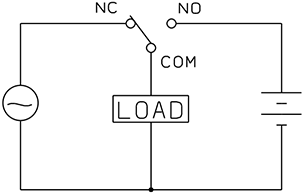Cautions in Using The Relays
使用继电器时的注意事项只有英语版。
Cautions for using the relay are mentioned hereafter and please read them before use. Also, in order to increase the reliability when you use the relay, confirm the actual conditions of your usage
⚠ Don't touch the relay terminal (charged parts) during the electric circulation, for you may receive an electric shock.
-
CAUTION FOR HANDLING
- Don't expose the relay in vibration and shock exceeding the specification level in order to maintain the initial performance.
- Don't disassemble the relay
You may not be able to maintain the initial performance. -
Handling of stick packaging
If a fractional amount remains, stopper as shown in the diagram is used, so that the relay will not move. If the relay moves inside the stick, it causes the problem to maintain the initial performance.
-
CAUTION CONCERNING THE COIL
- Maximum allowable voltage
The maximum allowable voltage of the coil is determined by the coil wire material, the heat-resistant temperature of the construction resin material, and the temperature rise level of the coil. Also, since the coil temperature rise differs according to ambient temperature, the maximum allowable voltage differs with ambient temperature. For further details, refer to the characteristics of the maximum allowable voltage of the respective relays. If the voltage applied to exceed the maximum allowable voltage, it may result in layer short of the coil and or burned damage, so it is necessary for you to take care. - Since the operate voltage normally rises by about 0.4%/degree Celsius because of the ambient temperature of the relay, when you use it in high humidity surrounding, consider carefully what is necessary to meet the terms and conditions for the actual use. Furthermore, when the voltage is applied to the relay coil, the operation voltage may occasionally rise due to heat generation of the coil itself.
- It is fundamental that you apply the rated voltage to the coil. Also, apply square waves to the coil.
- If you continually circulate electricity to the coil for a long time, there is a possibility of causing corrosion due to the heat resulting from a rise of the coil temperature and it may cause contact hindrance. In this case, consider using self-maintained type latching relay.
- Latching relay
● Always connect polarity (+) and (-) as shown in the Relay Terminal Arrangement Drawing (Internal wire connection drawing). Also, don't apply voltage to the 2 coil latching type set coil and reset coil at the same time.
● When shipping out the product, the product is in reset condition, but it may occasionally shifts to the set condition by vibration and shock during transportation. Therefore, please make sure that all parts fit properly before usage.
-
Coil electrolytic corrosion
When the allowable voltage for the relay coil is relatively high, if you circulate electricity to the coil for a long time under high temperature and high humidity, electrolytic corrosion may occurs, which may occasionally cause the breaking of a wire. The following are examples of use, so take sufficient care.Example of circuit for electrolytic

- Maximum allowable voltage
-
CONTACT POINT CAUTION
- Don't exceed contact rating, as it may cause smoke and/or fire.
- It may occur occasionally that the life of the contact may be significantly shortened according to the kind contact load, switching frequency, ambient temperature and humidity, etc., so, confirm by the actually using circuit.
- In case of AC load, if you conduct synchronous switching the optionally fixed phase, it will have significant affect on the switching life. As long as there is no special instruction, the switching of the AC load is at the value conducted by random phase control.
- Micro load
When using the micro load, since there can be significantly differences in its contact performance, confirm by use of the data or contact us. -
Contact protection circuit
When you open and/or close the inductive load of the solenoid and/or motor, there is a possibility that from hundreds to thousands of Volts of counter electromotive force may occur and it may shorten the life of the contact significantly by arcing.Examples of contact protection circuit are as follows.Example of Contact protection circuit for inductive loads

Mount the contact protection circuit near the contact point (within 50cm). Also, avoid using the following protection circuit.
Bad example

-
Prohibited Circuit
When a short-circuit occurs between form A contact and form B contact circuit construction at the power source, which causes short-circuiting, is prohibited and must not be used.
-
USAGE ENVIRONMENT
- Concerning ambient temperature
- Use within the ambient temperature range for the respective relays. If it is not used within the ambient temperature range, it will greatly affect the insulation property and/or contact life.
- Concerning ambient humidity
- Use it in the atmosphere of less than 85%RH. If even sealed type relay is exposed in the atmosphere of high temperature and high humidity, it may absorb moisture with the water absorption property of plastic, and may occasionally cause the operation fault of the relay.
- Dust and malignant gas
- Don t use in the atmosphere of significant level of dusts, sulfide gas (SO2 , H2S) or organic gas. It causes hindrance in the operation. In such atmosphere please use the sealed type relay. However, plastics have breathing characteristics and please take sufficient care when the relay is exposed in the malignant gas for a long time.
- Air pressure
- Use in the range of air pressure of 1013hPa plus-minus 20%.
- Concerning vibration and shock
- Take care not to add vibration and shock to the relay exceeding the limits shown in the catalogue. Otherwise, it may cause the faulty and defective operation.
- Influence of magnetic field
- If strong external magnetic field is added to the relay, it may cause the faulty operation. Therefore, take care when mounting transformers, solenoids, magnets, etc. near the relays. Also, if you mount polarized relays closely the characteristics of the relay may occasionally change by the influence of the permanent magnet housed in the relay. In such cases, please consult us.
-
CAUTIONS FOR MOUNTING RELAY ON PC BOARD
- Mounting of relay
-
● Don't bend the terminals to make it self-supporting.
● If the relay is chucked during automatic mounting, please don't chuck hard the cover, for it may cause the damage and change of the characteristics.
- Flux plating
-
● Take care that flux does not overflow onto the surface of the printed circuit board.
● When using flux, use non-corrosive rosin type flux.
- Preheating
-
● Be sure to preheat.
● Preheating under the following terms and conditions.
Temperature : Less than 100 degree Celsius
Time : Within 1 minute● Don't leave the relay in high temperature for a long time to avoid failure and characteristics changes of the relay.
- Soldering
-
● In case of automatic soldering
Flow soldering is recommended.
Soldering temperature: approx. 250 degree Celsius (Max. 270 degree Celsius)
Soldering time : within 5 seconds
Solder : JIS Z3282, H60 or H63● In case of manual soldering
Soldering iron : 30 to 60W
Iron tip temperature : approx. 300 degree Celsius
Soldering time : Within 3 seconds
- Cooling
-
● As soon as automatic soldering is finished, cool down by blowing wind immediately, so that the relay and/or other parts may not be deteriorated by the heat.
● If you clean a sealed type relay, don t soak it in cold liquid such as cleaning fluid immediately after the soldering is finished. It may cause the damage sealing.
- Cleaning
-
● Use an alcohol type cleaning agents.
● Don t use trichlen, chrolothen, thinner, benzyl alcohol, etc. If such agents are used, it may cause damage of the case Avoid ultrasonic cleaning. Boiling cleaning is recommended.
- Coating
-
● Take sufficient care to select coating agent in order to avoid bad affection to the relay.